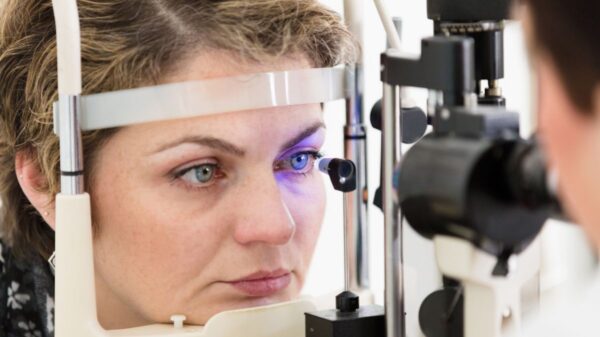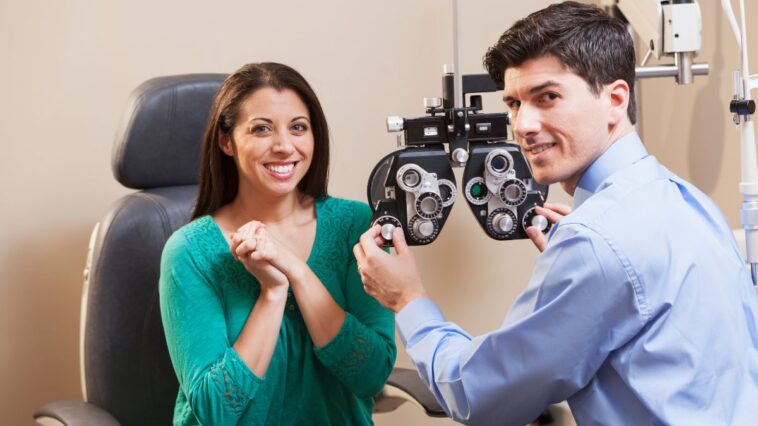Free eye exams are a service provided by optometrists, ophthalmologists, or other organizations, where individuals can check their vision at no cost. The exam typically includes the following:
- A visual acuity test.
- A test of the eye muscles and the ability to focus.
- A test of the eye’s ability to perceive colors.
The eye doctor may also evaluate the eyes’ health, including the eyelids, cornea, iris, lens, and retina. The exam may also include dilation of the pupils to get a better view of the back of the eye. After the exam, the eye doctor may prescribe glasses or contact lenses or refer the patient to a specialist if necessary.
Free eye exams may be offered to specific groups of individuals, such as children, seniors, low-income individuals, and those without insurance.
Some programs and organizations provide free eye exams to those in need through partnerships with local optometrists and ophthalmologists.
While the eye exam may be free, there may still be a cost for eyeglasses or contact lenses. However, many programs also offer assistance with the cost of these items.
Free Eye Exams For Adults
Free eye exams for adults are available through various programs and organizations. Many optometrists and ophthalmologists offer free eye exams to low-income individuals and those without insurance.
Additionally, some states have programs that provide free or low-cost eye exams for adults. These programs may be run through state-funded health clinics or partnerships with local optometrists and ophthalmologists.
Some organizations, such as VSP Global, offer free eye exams for adults through their charitable programs. These programs are often available to those with specific qualifications, such as low-income individuals or veterans.
If you need an eye exam and are an adult, it’s worth checking with local optometrists and ophthalmologists to see if they offer free exams. Reaching out to organizations such as VSP Global and inquiring about state-funded programs can also be a great resource. These opportunities can ensure everyone has access to proper vision care.

Free Eye Exams For Children
Free eye exams for children are available through various programs and organizations. Many optometrists and ophthalmologists offer children free eye exams, especially those covered by Medicaid or other government-funded health insurance programs.
Additionally, some states have programs that provide free or low-cost eye exams for children. These programs may be run through state-funded health clinics or partnerships with local optometrists and ophthalmologists.
Some organizations, such as Lions Club International, offer children free eye exams through their charitable programs. These programs are often available to those with specific qualifications, such as low-income families or children from underprivileged backgrounds.
Many states in the United States require children to have an eye exam before starting school. Parents should check with their local school district to see if this is the case in their area and to find out if there are any options for free or low-cost eye exams.
If you need an eye exam for your child, it’s worth checking with local optometrists and ophthalmologists to see if they offer free exams.
Reaching out to organizations such as Lions Club International and inquiring about state-funded programs can also be a great resource. These opportunities can ensure that all children have access to proper vision care.
Children’s Health Insurance Program (CHIP)
The Children’s Health Insurance Program (CHIP) is a federal-state partnership that provides health insurance coverage to children in low-income families. CHIP is designed to provide health insurance coverage to children whose families make too much money to qualify for Medicaid but cannot afford private health insurance.
The program is administered by the states but funded by state and federal governments.
CHIP provides comprehensive health coverage to children, including preventive care, doctor visits, hospital care, prescription drugs, and dental and vision care. The program also provides coverage for children with special needs and disabilities.
Eligibility for CHIP varies by state, but children are generally eligible if their family’s income is above the Medicaid threshold but below a certain level determined by the state. In some states, the CHIP program is open to children up to age 19; in others, it is only open to children up to age 18.
One of the main benefits of CHIP is that it provides health insurance coverage to children who would otherwise be uninsured. This means that children can access the medical care they need when they need it without having to worry about the cost. Also, CHIP can help reduce the financial burden on families and improve children’s health outcomes.
Free Eye Exams Covered by Medicaid
Eye exams are covered under Medicaid, the joint federal and state program that provides health coverage to low-income individuals and families. This means that enrolled individuals in Medicaid are eligible for free eye exams.
The services covered by Medicaid may vary from state to state, but eye exams, glasses, and contact lenses are generally covered for children and adults. Some states also cover additional services such as eye surgery, treatment for eye diseases, and low vision aids.
Not all optometrists and ophthalmologists accept Medicaid, so it’s essential to check with providers in your area to see if they participate in the program.
To take advantage of the free eye exams covered by Medicaid, individuals should check with their state’s Medicaid program to see if they qualify and to find out how to enroll. They should also check with local providers to see if they accept Medicaid and to schedule an appointment.
It’s worth noting that Medicaid is a joint federal and state program, and the specific coverage may vary from state to state. So, it is essential to check the coverage of your specific state Medicaid program.
Eye Exams Covered by Medicare
Medicare covers a variety of eye exams, including annual eye exams for people with diabetes and glaucoma and one-time eye exams for people with certain risk factors for eye disease. However, routine eye exams for prescribing glasses or contacts are not covered by Original Medicare (Part A and Part B).
Some Medicare Advantage plans (Part C) may offer additional coverage for routine eye exams and vision services. It’s best to check with your plan or provider to see what specific services are covered.
Free Eyeglasses
Free eyeglasses refer to a program or initiative that provides eyeglasses to individuals who cannot afford them. These programs are often run by non-profit organizations, charities, or government agencies and are designed to help low-income, uninsured, or underinsured individuals.
One of the main benefits of free eyeglasses is that they can help to improve an individual’s quality of life. Poor vision can do reading, working, or even navigating daily activities difficult. Eyeglasses can help to correct vision problems and make it easier for individuals to participate in daily activities. Also, free eyeglasses can help improve an individual’s self-esteem and confidence, as they can see clearly and participate in daily activities more efficiently.
Another benefit of free eyeglasses is that they can help to prevent more severe health problems. Poor vision can lead to eye strain, headaches, and even accidents. Eyeglasses can help to correct vision problems and prevent these issues. Free eyeglasses can also help prevent more severe health issues, such as diabetes, which can lead to blindness.
Several organizations offer free eyeglasses to those in need, including non-profit organizations, charities, and government agencies. Some organizations, such as the Lion’s Club, provide free eyeglasses to children. Other organizations, such as VSP Global, offer free eyeglasses to low-income individuals.
Cheap Eye Exams for Adults
There are several options for low-cost or affordable eye exams for adults. Some optometrists and ophthalmologists offer reduced-fee exams for low-income individuals and those without insurance.
Additionally, some retail stores and optical chains such as America’s Best, Pearle Vision, and Target Optical offer low-cost eye exams, sometimes bundled with purchasing glasses or contacts.
It’s also worth checking with local health clinics and community health centers, as they may offer low-cost or sliding-scale fee exams.
Another option to consider is purchasing a vision insurance plan, which can provide coverage for eye exams and other vision-related expenses at a reduced cost.
Lastly, some non-profit organizations, like VSP Global and Lions Club International, offer low-cost or free eye exams and glasses to those in need. These programs are often run through partnerships with local optometrists and ophthalmologists.
It’s essential to check with each provider or organization to see if they offer low-cost eye exams and to inquire about any qualifications or conditions that must be met to receive the reduced fee.






